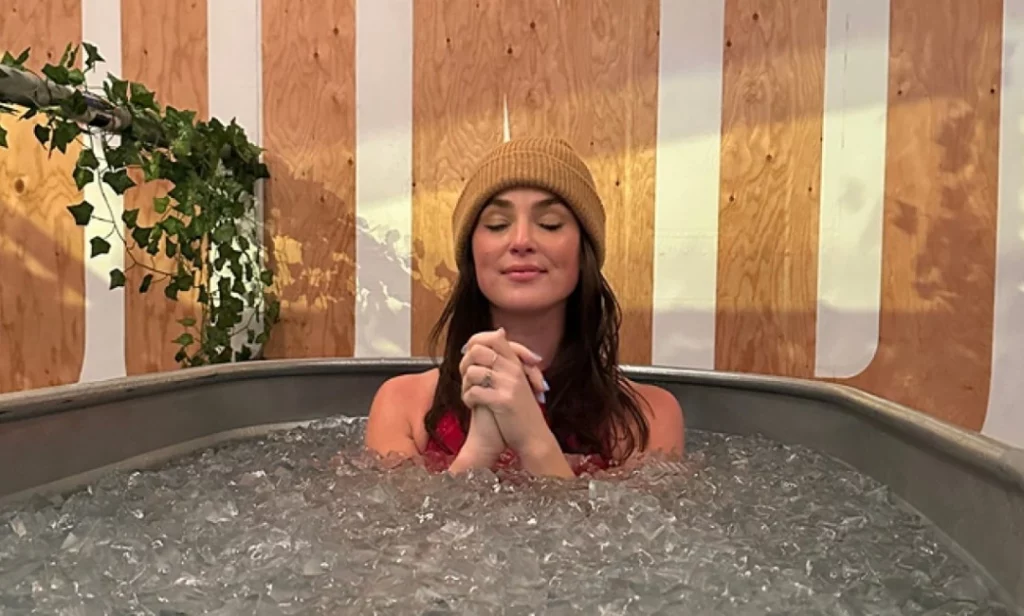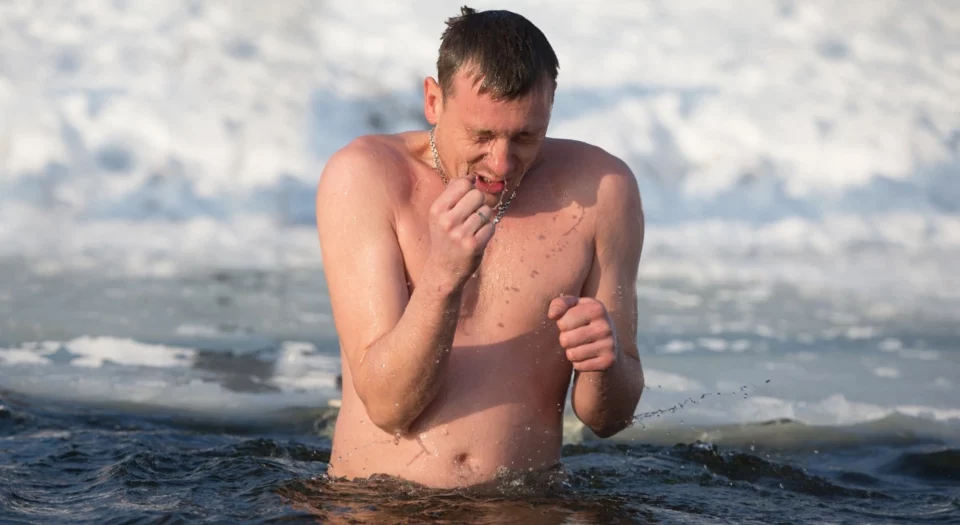Feeling sore, low on energy, or just mentally stuck? A few minutes in cold water might be all it takes to reset. From fitness fans to wellness seekers, more people are turning to cold plunges for faster recovery, better focus, stress relief, and an easy boost in overall wellness. Just grab a tub and some ice, you can try a cold plunge at home and see how it feels for yourself.
What Is a Cold Plunge? (For Beginners)
A cold plunge is a simple wellness practice where you sit in cold water, usually between 10°C to 15°C (50°F to 59°F), and for about 2 to 10 minutes.
You can use a regular tub with ice (DIY style) or a cold plunge setup that keeps the water chilled automatically. It’s part of a broader wellness called cold water immersion therapy, often used by athletes and biohackers to speed up recovery and improve focus.
But it’s not just for athletes. Cold plunging can help anyone feel better, reducing soreness, boosting mood, calming the mind, and supporting overall health. As many wellness seekers say, “It’s like hitting a reset button, just five minutes in cold water feels like meditation and deep-tissue massage.” It’s a simple habit anyone can try, right at home.
Top Cold Plunge Benefits
These are the most noticeable benefits people notice most when they cold plunge regularly.
- Relieves muscle soreness and speeds up workout recovery
- Lifts your mood by triggering feel-good brain chemicals
- Improves focus, alertness, and mental clarity
- Promotes better sleep and stress relief
- Reduces inflammation and swelling
- Supports healthy blood circulation and cardiovascular function
- Strengthens immune response over time
Why People Are Loving Cold Plunges?
People aren’t jumping into freezing water just for fun, it’s because they actually feel the difference. Whether it’s quicker recovery after a workout, a mental reset after a stressful day, or a way to build mental discipline, cold plunging has become a favorite ritual for many.
Also Check: George Foreman Home Warranty Review: Should You Trust It?
Fitness lovers use it to bounce back faster. Biohackers love the focus and mental clarity. Wellness seekers turn to it for better sleep, less stress, and a boost of natural energy. The best part? It’s quick, easy to do at home, and barely costs anything, you just need a tub and some ice.
Ice Bath vs. Cold Plunge: Any Difference?
| Category | Ice Bath | Cold Plunge |
| Effectiveness | Full cold therapy benefits | Same benefits, more consistent |
| Temperature | Fluctuates with ice/water | Precisely controlled |
| Comfort | Harsher, direct ice contact | Smoother, more tolerable |
| Accessibility | Easy DIY setup | Requires a plunge setup |
| Consistency | Varies by prep and water | Same temp every time |
Note – Both offer powerful benefits, ice baths are easy to start with, while cold plunges deliver more comfort and fits more easily into your daily habits.
How to Cold Plunge at Home? (DIY Setup)

Want to try cold plunging at home? Just grab a bathtub, big bin, or outdoor tub and fill it with cold tap water. You can add a few bags of ice to lower the temperature, but it’s not a must, cold tap water works fine when you’re just getting used to it. Have a timer handy to keep track of your time in the water, and keep a towel and some warm clothes nearby so you can warm up gradually after your plunge.
Steps to Prepare:
- Fill your tub or bin with cold water. Add ice if available.
- Aim for a temperature around 10–15°C (50–59°F), but tap-cold is okay to start.
- Get into the water up to your chest, or your waist if you’re new.
- Start with 1 to 3 minutes. Set a timer and breathe steadily.
- Step out slowly and warm up with a towel and dry clothes.
- Avoid hot showers immediately, let your body reheat naturally.
That’s it. A simple, no-frills cold plunge, right at home.
How Long Is Safe for a Cold Plunge?
If you’re just starting out, 1 to 2 minutes is plenty. That short time still gives your body a strong dose of the benefits. Once you’re used to it, you can stretch it to 3 to 5 minutes. Some people go for 10 minutes once they’re used to it, but only if it feels right for you, stick to what you’re comfortable with.
You May Also Like: Age Limits For Children On Flights And Airline Travel Policies.
If you get too cold, feel dizzy, or go numb, get out right away. As many fitness coaches and wellness enthusiasts describe it, “The first 60 seconds are the hardest. After that, your mind quiets down, and your body starts to adjust. It feels surprisingly peaceful.” Cold plunging is not about pushing limits, it’s about being consistent and staying safe.
What’s Better Cold Plunge Before or After a Workout?
Many people wonder whether it’s better to cold plunge before or after a workout. The answer depends on your goal. If recovery is your goal, cold plunging after a workout is the way to go, it helps ease soreness, reduces inflammation, and leaves you feeling refreshed.
But if you’re lifting heavy or trying to build strength, it’s better to skip the plunge beforehand. Cold exposure before training can slightly reduce performance and slow muscle gains. For most fitness lovers and wellness-focused folks, cold plunging after exercise is the smarter move. It supports recovery and helps your body stay strong for the next session.
Cold Plunge Safety & Best Practices
Cold plunging is generally safe for most people, but there are a few things to keep in mind, especially if you’re new. For the first few plunges, it’s smart to have someone nearby. If you have heart issues or very low blood pressure, check with your doctor first. Feeling cold is normal, but if you notice sharp pain, dizziness, or numbness, get out immediately.
After your plunge, skip the hot shower and warm up gradually by drying off, walking around, or sipping something warm. The goal is to feel better, not worse. So take it slow, stay consistent, and pay attention to how your body responds.
Why Biohackers and High Performers Swear By It
Cold plunging isn’t just about recovery, it’s a mental reset. That first moment when you sink into cold water? Everything in you says “nope.” But if you stay, even just for a minute, something shifts. You start to build real mental toughness.
Related: Does Almond Milk Yogurt Contain Algae Based Ingredients?
That’s why a lot of biohackers and high performers are hooked. It helps regulate dopamine, keeps stress in check, and boosts focus throughout the day. You step out feeling clear, calm, and more in control.
For wellness seekers, it’s not about pushing limits, it’s about consistency. Cold plunging is a simple daily habit that builds resilience, boosts recovery, and helps you stay grounded, both mentally and physically.
Final Thoughts
If you want to recover faster, focus better, and feel more balanced, cold plunging is worth a try. You don’t need fancy gear or intense routines, just cold water, a few minutes, and little consistency. It’s not magic, but it works. Stick with it, and you may feel a real shift, less soreness, more clarity, and a steadier mind. Start simple. Use what you have. See how your body responds. For many, it’s not just a wellness trend, it’s a habit that sticks.
FAQ’s
1. Can I cold plunge every day?
Yes, but ease into it. If you’re new, begin with 3–4 sessions per week. Once your body adjusts and you consistently feel good after each plunge, doing it daily is totally fine.
2. What’s the ideal cold plunge temperature?
Anywhere between 10°C to 15°C (50°F to 59°F) works well. You don’t need freezing temps, just cool enough to activate the benefits like muscle recovery and mental sharpness.
3. How long should I stay in?
If you’re just starting out, 1–2 minutes is plenty. Once you’re more used to it, you can slowly work up to 5–10 minutes. No need to push, just listen to your body and get out if it feels off
4. Is cold plunging safe for everyone?
For most people, yes. But if you have heart issues or low blood pressure, talk to your doctor first. Also, don’t do it alone the first few times, and always warm up slowly after.
5. What do I need to start at home?
All you need is a tub, big bucket, or bin, plus cold water. Ice helps, but it’s not required when starting out. No need for fancy setup to get started, just stay consistent and keep it simple.


